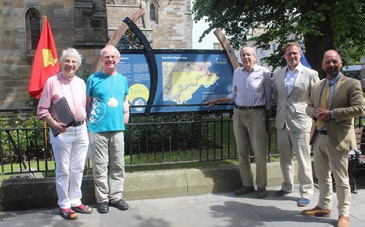Landmarks for pilgrim routes
Thomas Baldwin reports on causes for celebration for the Fife and Orkney pilgrim paths
THE teams behind two of Scotland’s new pilgrim routes are celebrating achieving major landmarks.
The first Gold standard Scottish Pilgrim Way accreditation has been awarded to the St Magnus Way in Orkney; while on the Fife Pilgrim Way, the final gateway panel at St Andrews has been unveiled and dedicated.
The 58-mile St Magnus Way, crossing the west Mainland of Orkney and the island of Egilsay, traces the journey taken by the body of the Viking earl and patron saint of the Islands martyred in 1117, for re-interment in the cemetery at the kirk in Birsay. Some years later his bones were transferred to Kirkwall and eventually placed in the shrine in the Cathedral that was built in his honour.
The route was created in 2017 and 2018, when all six sections were opened, waymarked and fully interpreted both on the ground and via the website and an app created with digital navigational aids, recently updated. A virtual route is also being made available including drone footage and other media.
The Gold award certificate will be presented in Kirkwall Cathedral at a special event on September 30 during the 2023 Scottish Pilgrimage Gathering organised by SPRF, the first time the Forum will have met on the Northern Isles in its 11 year history.
Stuart Little, Chair of Orkney Pilgrimage, said “We are delighted to have been awarded Gold accreditation by SPRF. It is very affirming to have had a thorough assessment of the route, website, app, organisation etc, and this award recognises and validates the huge amount of work done by our Trustees and volunteers. Those now coming to walk the St Magnus Way have the assurance that it's not just us that think it is worth making a pilgrimage in Orkney.”
The Fife Pilgrim Way was opened in 2019 and covers 64 miles from Culross to St Andrews. The final gateway panel, in the grounds of Holy Trinity Church, shows the route with beautiful illustrations depicting the life of medieval pilgrims and the places they travelled through on the road to St Andrews.
The Rev Professor Ian Bradley, author of The Fife Pilgrim Way: In the Footsteps of Monks, Miners and Martyrs, said: “This is the final gateway panel on the Fife Pilgrim Way in two senses – the one closest to the pilgrim way’s final destination at St Andrews Cathedral and also the last to be put in position, four years after the Fife Pilgrim Way was officially launched.
“It has taken a considerable time to find a suitable place for this interpretation panel marking the end of the pilgrim way but there could hardly be a more appropriate one than in the garden of Holy Trinity Church, where it is clearly visible to all pilgrims coming along the final stretch of the route on South Street, St Andrews.

The Rev Marion Paton, the Rev Prof Ian Bradley, Nick Cooke (Secretary, Scottish Pilgrim Routes Forum), Jeremy Harris (Fife Coast and Countryside Trust CEO) and Douglas Spiers (Fife Council archaeologist) at the dedication of the gateway panel at Holy Trinity Church, St Andrews.
“I am delighted to be involved with the dedication of this gateway panel which has already attracted much interest among visitors and townsfolk. I hope it will inspire more people to become pilgrims.”
Graham Wynd, of Holy Trinity Church, said: “We are especially glad to have been chosen as the site of the final Fife Pilgrim Way gateway panel. We are sure that this distinctive sign in such a prominent position will draw many more visitors into our building, whether they are starting or finishing their walk on the Fife Pilgrim Way or are simply passers-by. We look forward to welcoming them all.”
St Magnus Way:
www.stmagnusway.com
Fife Pilgrim Way: fifecoastandcountrysidetrust.co.uk/walks/fife-pilgrim-way/
Scottish Pilgrim Routes Forum: www.sprf.org.uk